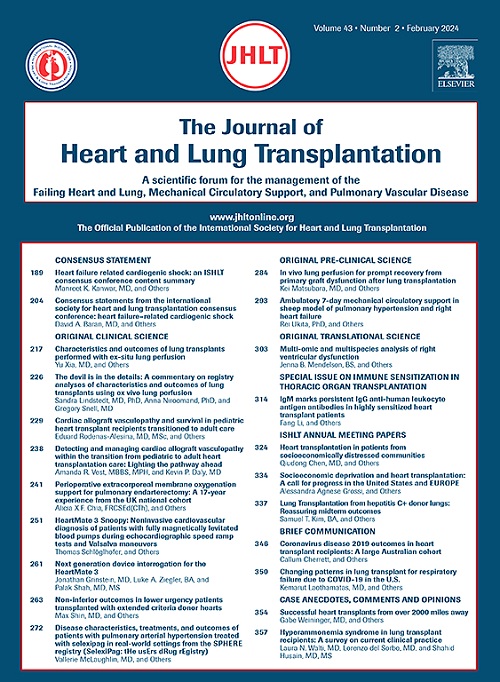使用双能 X 射线吸收测定法 (DXA) 对肺移植术后患者进行低骨矿物质密度 (BMD) 筛查的最佳监测频率。
IF 6.4
1区 医学
Q1 CARDIAC & CARDIOVASCULAR SYSTEMS
引用次数: 0
摘要
背景:美国每年进行约 2700 例肺部移植手术。这些患者罹患低骨矿物质密度(骨质疏松症/骨质疏松症)及随后发生与骨质疏松症相关骨折的风险增加。双能 X 射线吸收测量法(DXA)是筛查低骨矿物质密度的最常用方法,但使用 DXA 监测低骨矿物质密度的最佳频率尚不清楚:我们对 259 名患者(69.9% 为男性)进行了肺移植后股骨颈、总股骨、L1、L2、L3 和 L4 BMD 变化的回顾性队列评估,这些患者在移植后接受了连续 DXA 扫描随访,随访天数中位数为 725 天(四分位数间距 (IQR) (361-1116))。广义线性混合效应模型允许随机截距和随机斜率,并对性别、时间、时间平方、基线骨质疏松症/骨质疏松症、活动性排斥及其交互项进行调整,用于模拟各部位 BMD 的变化率。股骨颈、L1 和 L4 BMD 测量的最终多变量模型具有随机斜率和截距,全髋、L2 和 L3 测量的模型具有随机斜率:65%的肺移植患者在移植前患有骨质疏松症或骨质疏松症。与女性相比,男性在所有部位的基线 BMD 水平都更高(PC结论:接受肺移植手术的患者平均骨质疏松症发生率应低于女性:根据目前国际心肺移植学会(ISHLT)的指导方针,接受肺移植的患者在移植后的头两年平均每年都应接受一次 DXA 筛查。本文章由计算机程序翻译,如有差异,请以英文原文为准。
Optimized surveillance frequency for low bone mineral density (BMD) screening using dual-energy X-ray absorptiometry (DXA) in patients after lung transplant
Background
Approximately 2,700 lung transplants are performed annually in the United States. These patients are at increased risk of developing low bone mineral density (BMD) (osteopenia/osteoporosis) and subsequent fractures. Dual-energy X-ray absorptiometry (DXA) is the most common method used for screening for low BMD; however, the optimal surveillance frequency for low BMD using DXA is unknown.
Methods
We evaluated the change in femoral neck, total femur, L1, L2, L3, and L4 BMD after lung transplant in a retrospective cohort of 259 patients (69.9% male) who were followed with serial DXA scans for a median of 725 (interquartile range [361-1,116]) days after transplant. Generalized linear mixed-effects models adjusting for sex, time, time-squared, baseline osteopenia/osteoporosis, active rejection, and their interaction terms were used to model the rate of change of BMD at each site. The final multivariable models for the femoral neck, L1, and L4 BMD measurements had random slopes and intercepts, and the models for the total hip, L2, and L3 measurements had random slopes.
Results
Sixty-five percent of the patients undergoing lung transplants had osteopenia or osteoporosis before transplant. Men exhibited higher baseline BMD levels compared to women at all sites (p < 0.001 for all). After the transplant, the greatest rate of BMD decrease was at the femoral neck. Although patients with low BMD had significantly lower baseline BMDs (p < 0.001 for all), they experienced a slower rate of BMD decrease at all sites compared to patients with normal BMD at baseline (p < 0.001 for all). All patients received corticosteroids. Patients with low BMD at baseline had significantly higher odds of receiving bisphosphonate therapy (odds ratio = 3.95, 95% confidence interval [CI] [1.44, 13.51], p = 0.003). We estimated that a significant change in the femoral neck BMD would be expected to occur within 409 days (95% CI [131, 708]) and again at 867 days (95% CI [551, 1,216]) after lung transplant.
Conclusions
Patients undergoing lung transplant should be screened annually with DXA for the first 2 years after transplant, consistent with the current International Society for Heart and Lung Transplantation guidelines.
求助全文
通过发布文献求助,成功后即可免费获取论文全文。
去求助
来源期刊
CiteScore
10.10
自引率
6.70%
发文量
1667
审稿时长
69 days
期刊介绍:
The Journal of Heart and Lung Transplantation, the official publication of the International Society for Heart and Lung Transplantation, brings readers essential scholarly and timely information in the field of cardio-pulmonary transplantation, mechanical and biological support of the failing heart, advanced lung disease (including pulmonary vascular disease) and cell replacement therapy. Importantly, the journal also serves as a medium of communication of pre-clinical sciences in all these rapidly expanding areas.

 求助内容:
求助内容: 应助结果提醒方式:
应助结果提醒方式:


